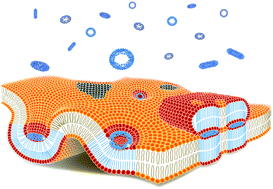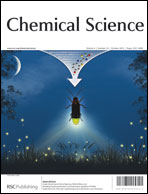Polyoxometalate macroion induced phase and morphology instability of lipid membrane†
Abstract
The interaction of multivalent macroions with cell membrane can have a profound and significant impact on the functionality and viability of the cell membrane, and this is also critically related to drug and gene delivery as well as nanomaterial cytotoxicity. Using AFM, calorimetry, and light scattering techniques, we have investigated the effect of an anionic polyoxometalate (POM) nanocluster as a model macroion on the phase and structural stability of a lipid bilayer. A POM is distinct from commonly used nanoparticles, in this case comprising a stoichiometric and ordered crystalline nanocluster of typically <5 nm in dimension with uniformly distributed high surface charge density. We have found that the anionic POM nanocluster can strongly adsorb onto a zwitterionic lipid bilayer, which is usually considered as neutral and uncharged, due to the strong electrostatic attraction in a similar fashion to the interaction of a POM with a cationic lipid bilayer. More interestingly, the adsorption of POM also results in the gelation of the lipid bilayer that is otherwise in the fluid phase in the absence of the POM macroion. By examining lipid bilayers with varied lipid headgroup chemistry and phase state, we have revealed that the energy released upon the POM adsorption on the lipid bilayer is contributed not only from the enthalpy associated with gelation, but also from the entropy associated with local surface reconstruction of the lipid bilayer. A POM-induced entropic penalty on the lipid bilayer is confirmed by both liposome shrinkage and bilayer morphological disruption, including the formation of pores, buds, and multilayer stacks on a POM-adsorbed lipid membrane. Hence, the accompanied phase and morphological instability induced by the POM is unique and surprising, in contrast to the fact that only one, but not both, of the phenomena has been reported previously with hydrophilic or hydrophobic nanoparticles. Our results offer an unprecedented new insight into nanomaterial design and selection for controlled molecular transport through cell membranes.


 Please wait while we load your content...
Please wait while we load your content...